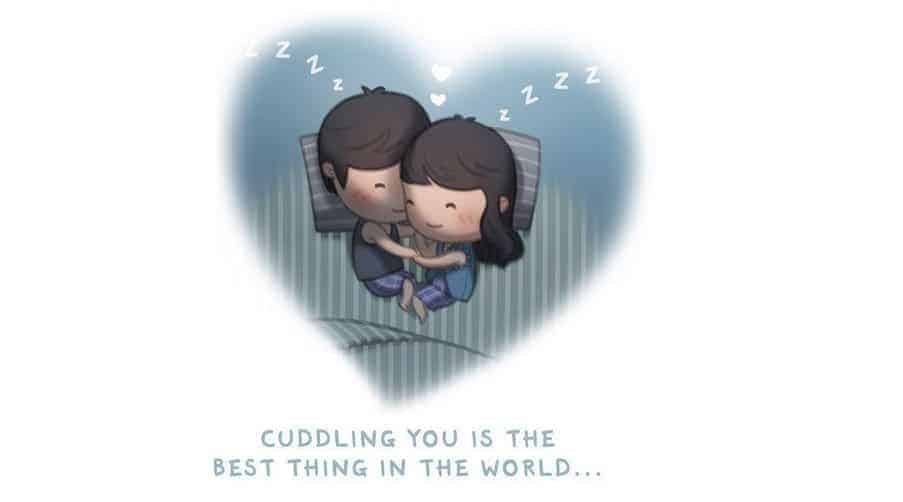Do you like to cuddle? Do you embrace the comfort of snuggling up against your love? Well, there may be some scientific reasoning behind these lovey-dovey feelings.
Our sense of touch is the very first sense that we develop. After just eight weeks in the womb, a 2.5-centimeter long embryo already has a highly developed sense of touch. Towards the end of life, our sense of touch is the last sense to diminish.
As it turns out, physical manifestations of touch are vital to psychological well-being. Katherine Harmon, an award-winning writer and journalist for Scientific American, wrote in 2010:
“…researchers have been discovering how emphasizing skin-to-skin contact between baby and parent can be a boon to both, and how consistent emotional engagement with infants can speed their development and recognition of self.”
Harmon notes, tragically, that babies who are deprived of touch and emotional engagement “are at a higher risk for behavioral, emotional, and social problems as they grow up.” These problems, Harmon states, could remain with a person throughout their life.
From Babies to the Bedroom…
Harmon’s research is mentioned for this reason: to demonstrate the incredible physical and psychological influence of human touch. We are biologically hardwired to receive touch and, as Harmon explains, the lack thereof can manifest into serious problems.
Which brings us to cuddling. Cuddling, as we all know, is the act of holding someone close as a way of showing love or affection. It is also one of the most intimately effective forms of touch. (Cuddling is also a common practice among members of the same sex – and the benefits are just as tangible.)
Here are a few of the things that science says happens to your body when you cuddle:
“Although poets and authors have tried to describe love, in the world of neuroscience, researchers have found that the naturally occurring hormone oxytocin and love are intimately related.” ~ Psychology Today
You Feel Happier
Cuddling stimulates release of the brain chemical oxytocin, one of the brain’s “feel-good” hormones. Some people also refer to oxytocin as the “love hormone,” as it creates strong feelings of relaxation, stability, and trust. Additionally, oxytocin also appears to reduce stress responses, including anxiety. It also positively influences bonding behavior.
Oxytocin also produces many physical and psychological effects. In females, oxytocin plays essential roles in reproductive functions, including breastfeeding, giving birth, and sexual activity.
You Feel More Connected
According to Dr. Fran Walfish, a renowned child, couple, and family psychotherapist in Beverly Hills, California, cuddling is a powerful way to bring two people close together:
“The most obvious benefit to cuddling is getting close to your partner in the physical sense. There is also the release of dopamine which is an excitatory hormone that increases sexual desire.”
Cuddling also enhances the bond between parents and babies. Science points to the release of neuropeptides as the reason for this effect.
You Communicate Better
As we all know, non-verbal communication is just as powerful as the verbal kind. We all want to be understood, and communication is the underpinning of empathy and understanding.
Sarah Watson, a licensed marriage counselor, says “Cuddling is such a great way for couples to connect! (It) helps us bond, and can lower anxiety, depression and blood pressure. I recommend cuddling to increase intimacy with your partner.”
You Feel Better Rested
In a study published by the Max Planck Institute of Psychiatry in Munich, Germany, researchers found that activation of parts of the brain’s HPA axis helps promote restfulness. More specifically, the actions of neuropeptides in the HPA axis regulate healthy sleep-wake behaviors.
Any couple that loves to cuddle can undoubtedly attest to the study’s findings. In fact, this biological response associated with cuddling may help explain why restful sleep is more difficult for couples when one is away from home.
Cuddling Tips
Samantha Hess, owner of ‘Cuddle Up To Me’ and self-proclaimed cuddle expert, gives some practical advice. While ‘cuddle advice’ may sound silly, Hess’ professional tips can make the experience more enjoyable while helping safeguard your physical health.
1. Be creative: Believe it or not, there are up to 58 (!) different cuddling positions. Do a bit of research and find what positions are most personally enjoyable and relaxing for you and your cuddle buddy!
2. Listen to your body: While the benefits of cuddling are very real, it doesn’t do any good if your body is in pain. Resting on your side too often, for example, can cause inflammation of the shoulder; too much pressure on your back can lead to back pain, etcetera. So don’t stay in the same position for too long and make sure to change things up!
3. Start slow: Not everyone is comfortable with cuddling up to someone else. Hess recommends starting with simpler positions – while reading, or laying back-to-back or side-by-side. These subtler cuddle spots may help warm you both up.


















